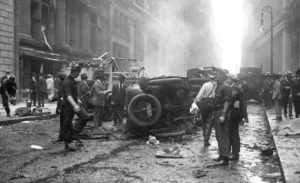Immigrants and Violence: Americans Were a Lot Braver in 1920
 Aftermath of the Galleanist bombing of Wall Street, 1920
Aftermath of the Galleanist bombing of Wall Street, 1920 On the night of June 2, 1919, the assistant secretary of the Navy, Franklin Delano Roosevelt, and his wife Eleanor walked past the home of Attorney General Mitchell Palmer. Just after they entered their house, which was across the street from the Palmer residence, a massive bomb exploded in front of the attorney general’s house. The bomb had gone off prematurely and body parts of the man responsible, Carlo Valdinoci, landed on the Roosevelt’s front porch. Valdinoci was an Italian anarchist.
That night anarchists, targeting government officials, had detonated seven other large bombs across the country. None of the targeted men were killed but many of their homes were badly damaged and a night watchman died from an explosion in New York City that night.
In April of that year the same anarchists sent thirty-six mail bombs to the homes and offices of high-ranking government officials and business leaders. Fortunately, most were discovered before detonating after an intended victim opened one from the wrong end. It failed to detonate and he was able to alert officials. However, the housekeeper of a senator had her hands blown off by one, and the senator’s wife had her face mangled.
Folks weren’t as lucky a year and a half later. On the morning of September 16, 1920, a horse-drawn carriage stopped in front of 23 Wall Street in lower Manhattan. It was packed with one hundred pounds of dynamite and cast iron sash weights. The massive bomb went off in front of J.P. Morgan Bank headquarters, killing thirty-eight people and grievously injured 143 more.
Those responsible for the violence were known as Galleanists—anarchists influenced by an Italian immigrant named Luigi Galleani who moved to the United States in 1901 and began preaching violent revolution in a working-class Italian immigrant neighborhood in New Jersey. For fifteen years he published a newsletter called Cronaca Sovversiva (Italian for Subversive Chronicle) that, at its peak, had 5,000 subscribers. It argued against the existence of God, called for free love, promoted attacks on officials and published the names and addresses of prominent government leaders and capitalists. In his newsletters Galleani also published detailed instructions for bomb making. The immigrants he spoke to were ripe for revolution due to their squalid living conditions and brutal work environment.
From 1914 to 1920 Galleanists spread across the United States and launched hundreds of deadly attacks. They attempted mass poisonings using arsenic, stabbed policemen, and bombed a police station in Milwaukee, killing nine officers and a woman.
All of this, as well as exaggerated fears of Bolshevism, triggered the Immigration Act of 1918 and the Sedition Act of 1918, which expanded the criteria that allowed for deportations and the suppression of free speech. Both were widely condemned at the time despite waves of attacks. It sparked the First Red Scare in which nativism swept the country and people were arrested, detained, and deported without warrant. It was used to justify labor union suppression and even racism. Americans became wary of immigration from southern and eastern Europe, and Italians were sometimes targeted in violent attacks. The scare passed quickly when predicted uprisings failed to materialize in the early 1920s.
The point here is that despite all of the injustices committed against our citizens at that time and the massive amount of attacks carried out by radicals, there was never a blanket immigration ban considered on Italian or eastern European immigrants. Even then, when people had much more concrete reasons to be afraid, we still protected the immigration and travel rights of Italians in general. Compare this to today’s fear about Muslim immigrants in the United States, where since 9/11 there have been but a handful of lone-wolf attacks by mostly native-born fanatics. History shows this recent executive order and mass paranoia to be truly unprecedented. Even during the early-twentieth-century wave of Italian anarchist attacks, our presidential candidates did not campaign on a platform of a sweeping Italian immigration ban.
Indeed, the day after the 1920 Wall Street bombing, thousands of Americans defiantly and bravely gathered for a previously scheduled patriotic rally at the exact same intersection. Today a whole lot of people are in favor of President Trump’s travel ban (in some polls as many as half of all Americans). What happened to the United States? How did we become so cowardly?
